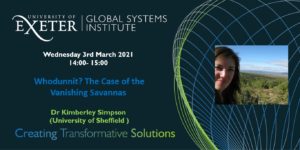
Taken from GSI Seminar coordinator Daneen Cowling’s Blog
The delicate balance between C3 trees and C4 grasses that has characterised the global Savannahs for millennia is now being compromised, threatening the existence of this biome. In this seminar, Dr Simpson assesses the potential ‘culprits’ behind the case of the vanishing Savannas,
Dr Simpson is a postdoctoral researcher at the University of Sheffield, in the department of Animal and Plant Science within the Osbourne Lab. Dr Simpson is broadly occupied in how processes create and maintain phenotypic diversity and how traits influence such processes. She is currently involved in a project investigating abiotic and biotic factors in woody encroachment in Savannas. She collaborates on field work with Rhodes University in South Africa, and is expanding on her PhD which investigated fire influence on grass functional traits.
To layout her investigation of what is causing a reduced Savanna, Dr Simpson first explained the context of the ‘victim’ in the case – the characteristics and geographic distribution of Savannah ecosystems. Then the ‘crime’ – the encroachment of trees and diminishing Savannah grasslands. Although the increased tree cover could have benefits in the form of increased fuel wood and Carbon sequestration, negative implications in the form of reduced foraging, groundwater, visibility and ecotourism also occur. But most detrimental, the shift threatens the many species reliant on these open landscapes.
Dr Simpson took the audience through a storyboard of potential ‘suspects’:
- Reduced Fire Frequency: Intensive grazing and fragmentation is contributing to a reducing in fire frequency. This is detrimental for grasses that are able to thrive and out-compete trees in systems of high fire frequency due to faster regeneration and shorter life-cycles of grasses relative to trees. Changes in fire frequency also drive phenotypic divergence in Savanna grasses, with a reduction coinciding with a reduction in ‘seeder’ species. This creates a feedback whereby fire frequency changes alter community composition, which as a result changes flammability. Current observations show a reduced fire frequency = more trees can reach maturity = grass biomass reduces = reduced flammability contributing to the reduced fire frequency trend.
- Elevated CO2: C3 trees have a high growth response to elevated CO”, whereas C4 grasses do not. But – elevated CO2 cannot explain the spatial variability in savanna change.
- Rainfall: Encorachment also correlates with rainfall and likely interacts with CO2 via stromata – C4 grasses have an improved photosynthetic rate during drought, whereas C3 trees respond well to high CO2 and H2O.
Dr Simpson concluded her investigation with the verdict: more evidence is needed!
In her upcoming projects, Dr Simpson hopes to unpick the various interactions, as well as the role of plant functional traits, as the case of the Savanna encroachment continues. Dr Simpson also hopes to investigate new influences in the case – such as the role of elephants able to bulldoze trees to maintian the ecosystem, and the controls of species that allows some to proper better than others.
To watch the recording of Dr Simpsons talk and the Q&A, click this link.
